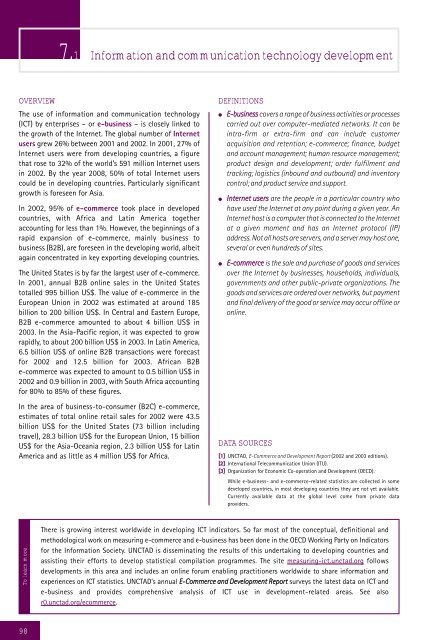Development and Globalization: - Unctad
Development and Globalization: - Unctad
Development and Globalization: - Unctad
Create successful ePaper yourself
Turn your PDF publications into a flip-book with our unique Google optimized e-Paper software.
OVERVIEW DEFINITIONS<br />
98<br />
7.1 Information <strong>and</strong> communication technology development<br />
The use of information <strong>and</strong> communication technology<br />
(ICT) by enterprises – or e-business – is closely linked to<br />
the growth of the Internet. The global number of Internet<br />
users grew 26% between 2001 <strong>and</strong> 2002. In 2001, 27% of<br />
Internet users were from developing countries, a figure<br />
that rose to 32% of the world’s 591 million Internet users<br />
in 2002. By the year 2008, 50% of total Internet users<br />
could be in developing countries. Particularly significant<br />
growth is foreseen for Asia.<br />
In 2002, 95% of e-commerce took place in developed<br />
countries, with Africa <strong>and</strong> Latin America together<br />
accounting for less than 1%. However, the beginnings of a<br />
rapid expansion of e-commerce, mainly business to<br />
business (B2B), are foreseen in the developing world, albeit<br />
again concentrated in key exporting developing countries.<br />
The United States is by far the largest user of e-commerce.<br />
In 2001, annual B2B online sales in the United States<br />
totalled 995 billion US$. The value of e-commerce in the<br />
European Union in 2002 was estimated at around 185<br />
billion to 200 billion US$. In Central <strong>and</strong> Eastern Europe,<br />
B2B e-commerce amounted to about 4 billion US$ in<br />
2003. In the Asia-Pacific region, it was expected to grow<br />
rapidly, to about 200 billion US$ in 2003. In Latin America,<br />
6.5 billion US$ of online B2B transactions were forecast<br />
for 2002 <strong>and</strong> 12.5 billion for 2003. African B2B<br />
e-commerce was expected to amount to 0.5 billion US$ in<br />
2002 <strong>and</strong> 0.9 billion in 2003, with South Africa accounting<br />
for 80% to 85% of these figures.<br />
In the area of business-to-consumer (B2C) e-commerce,<br />
estimates of total online retail sales for 2002 were 43.5<br />
billion US$ for the United States (73 billion including<br />
travel), 28.3 billion US$ for the European Union, 15 billion<br />
US$ for the Asia-Oceania region, 2.3 billion US$ for Latin<br />
America <strong>and</strong> as little as 4 million US$ for Africa.<br />
To learn more<br />
● E-business covers a range of business activities or processes<br />
carried out over computer-mediated networks. It can be<br />
intra-firm or extra-firm <strong>and</strong> can include customer<br />
acquisition <strong>and</strong> retention; e-commerce; finance, budget<br />
<strong>and</strong> account management; human resource management;<br />
product design <strong>and</strong> development; order fulfilment <strong>and</strong><br />
tracking; logistics (inbound <strong>and</strong> outbound) <strong>and</strong> inventory<br />
control; <strong>and</strong> product service <strong>and</strong> support.<br />
● Internet users are the people in a particular country who<br />
have used the Internet at any point during a given year. An<br />
Internet host is a computer that is connected to the Internet<br />
at a given moment <strong>and</strong> has an Internet protocol (IP)<br />
address. Not all hosts are servers, <strong>and</strong> a server may host one,<br />
several or even hundreds of sites.<br />
● E-commerce is the sale <strong>and</strong> purchase of goods <strong>and</strong> services<br />
over the Internet by businesses, households, individuals,<br />
governments <strong>and</strong> other public-private organizations. The<br />
goods <strong>and</strong> services are ordered over networks, but payment<br />
<strong>and</strong> final delivery of the good or service may occur offline or<br />
online.<br />
DATA SOURCES<br />
[1] UNCTAD, E-Commerce <strong>and</strong> <strong>Development</strong> Report (2002 <strong>and</strong> 2003 editions).<br />
[2] International Telecommunication Union (ITU).<br />
[3] Organization for Economic Co-operation <strong>and</strong> <strong>Development</strong> (OECD).<br />
While e-business- <strong>and</strong> e-commerce-related statistics are collected in some<br />
developed countries, in most developing countries they are not yet available.<br />
Currently available data at the global level come from private data<br />
providers.159.<br />
There is growing interest worldwide in developing ICT indicators. So far most of the conceptual, definitional <strong>and</strong><br />
methodological work on measuring e-commerce <strong>and</strong> e-business has been done in the OECD Working Party on Indicators<br />
for the Information Society. UNCTAD is disseminating the results of this undertaking to developing countries <strong>and</strong><br />
assisting their efforts to develop statistical compilation programmes. The site measuring-ict.unctad.org follows<br />
developments in this area <strong>and</strong> includes an online forum enabling practitioners worldwide to share information <strong>and</strong><br />
experiences on ICT statistics. UNCTAD’s annual E-Commerce <strong>and</strong> <strong>Development</strong> Report surveys the latest data on ICT <strong>and</strong><br />
e-business <strong>and</strong> provides comprehensive analysis of ICT use in development-related areas. See also<br />
r0.unctad.org/ecommerce.

















